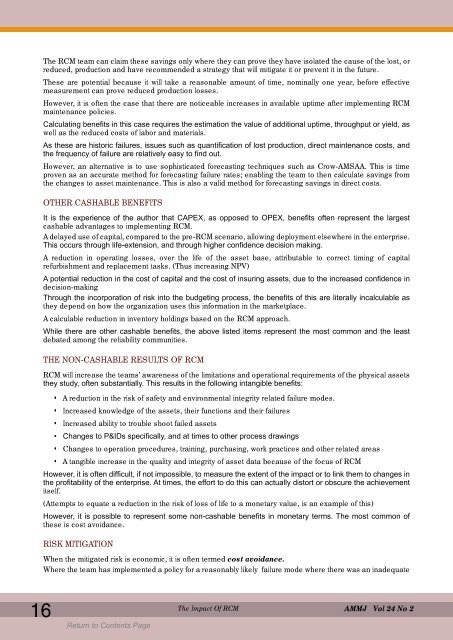April - Library
April - Library
April - Library
Create successful ePaper yourself
Turn your PDF publications into a flip-book with our unique Google optimized e-Paper software.
16<br />
The RCM team can claim these savings only where they can prove they have isolated the cause of the lost, or<br />
reduced, production and have recommended a strategy that will mitigate it or prevent it in the future.<br />
These are potential because it will take a reasonable amount of time, nominally one year, before effective<br />
measurement can prove reduced production losses.<br />
However, it is often the case that there are noticeable increases in available uptime after implementing RCM<br />
maintenance policies.<br />
Calculating benefits in this case requires the estimation the value of additional uptime, throughput or yield, as<br />
well as the reduced costs of labor and materials.<br />
As these are historic failures, issues such as quantification of lost production, direct maintenance costs, and<br />
the frequency of failure are relatively easy to find out.<br />
However, an alternative is to use sophisticated forecasting techniques such as Crow-AMSAA. This is time<br />
proven as an accurate method for forecasting failure rates; enabling the team to then calculate savings from<br />
the changes to asset maintenance. This is also a valid method for forecasting savings in direct costs.<br />
OTHER CASHABLE BENEFITS<br />
It is the experience of the author that CAPEX, as opposed to OPEX, benefits often represent the largest<br />
cashable advantages to implementing RCM.<br />
A delayed use of capital, compared to the pre-RCM scenario, allowing deployment elsewhere in the enterprise.<br />
This occurs through life-extension, and through higher confidence decision making.<br />
A reduction in operating losses, over the life of the asset base, attributable to correct timing of capital<br />
refurbishment and replacement tasks. (Thus increasing NPV)<br />
A potential reduction in the cost of capital and the cost of insuring assets, due to the increased confidence in<br />
decision-making<br />
Through the incorporation of risk into the budgeting process, the benefits of this are literally incalculable as<br />
they depend on how the organization uses this information in the marketplace.<br />
A calculable reduction in inventory holdings based on the RCM approach.<br />
While there are other cashable benefits, the above listed items represent the most common and the least<br />
debated among the reliability communities.<br />
THE NON-CASHABLE RESULTS OF RCM<br />
RCM will increase the teams’ awareness of the limitations and operational requirements of the physical assets<br />
they study, often substantially. This results in the following intangible benefits:<br />
• A reduction in the risk of safety and environmental integrity related failure modes.<br />
• Increased knowledge of the assets, their functions and their failures<br />
• Increased ability to trouble shoot failed assets<br />
• Changes to P&IDs specifically, and at times to other process drawings<br />
• Changes to operation procedures, training, purchasing, work practices and other related areas<br />
• A tangible increase in the quality and integrity of asset data because of the focus of RCM<br />
However, it is often difficult, if not impossible, to measure the extent of the impact or to link them to changes in<br />
the profitability of the enterprise. At times, the effort to do this can actually distort or obscure the achievement<br />
itself.<br />
(Attempts to equate a reduction in the risk of loss of life to a monetary value, is an example of this)<br />
However, it is possible to represent some non-cashable benefits in monetary terms. The most common of<br />
these is cost avoidance.<br />
RISK MITIGATION<br />
When the mitigated risk is economic, it is often termed cost avoidance.<br />
Where the team has implemented a policy for a reasonably likely failure mode where there was an inadequate<br />
The Impact Of RCM<br />
AMMJ Vol 24 No 2
















